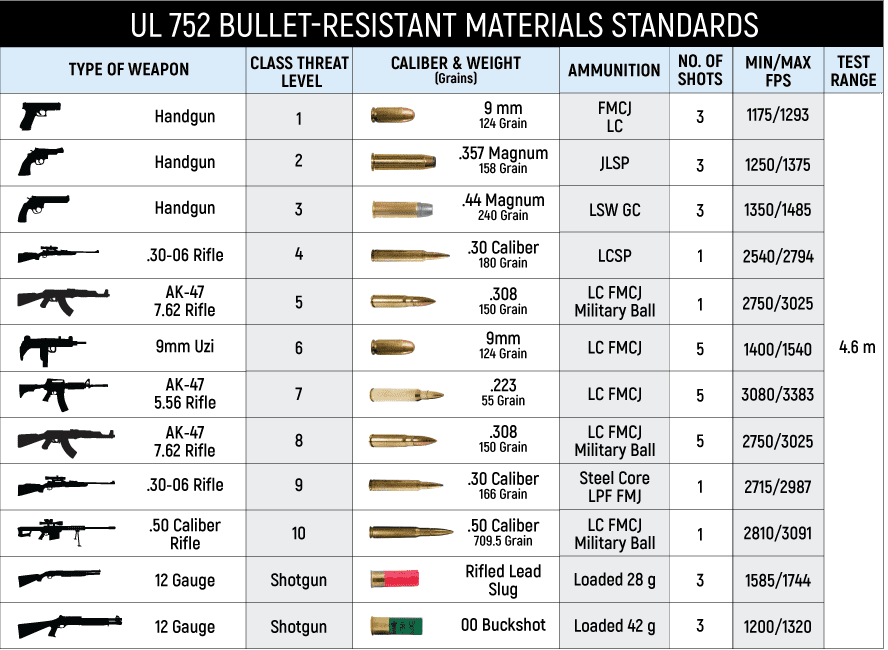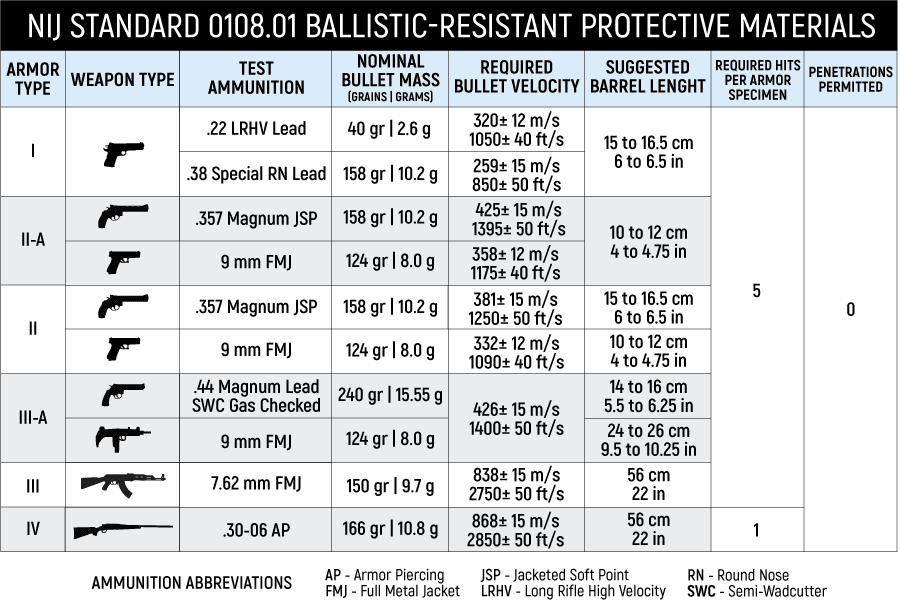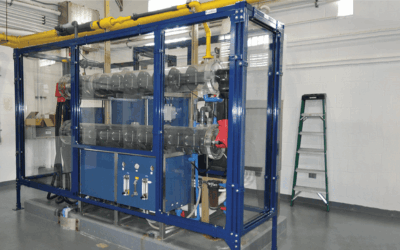At TotalShield, we use polycarbonate to construct our shield rooms, protective barriers, and machine guards because it is an exceptionally strong material with outstanding ballistic performance. But just how strong is polycarbonate? How do manufacturers rate their products for ballistic resistance, and how do testing agencies and standards bodies classify the polycarbonate ballistic resistance?
We are going to do a deep dive into this topic, but let’s cut to the chase:
- Almost all standards for ballistic resistance applied to polycarbonate involve resistance to bullets
- We don’t use the term “bulletproof”, we use “bullet-resistant”. You can find out why in our blog post “Blast-proof and Explosion-proof Enclosures: Do They Exist?”
- Bullet resistance is not a great metric for industrial users, who are typically concerned with larger items traveling at slower speeds than bullets in a failure scenario, but it does offer some useful information when understanding how tough polycarbonate is when struck by a ballistic object of any type
Let’s cover some polycarbonate background information and then move on to a detailed analysis.
What is Polycarbonate?
Polycarbonate (PC) is a thermoplastic discovered in 1953 in both the United States and Germany. In Pittsfield, MA, Daniel Fox accidentally discovered it while working on a wire-coating material for General Electric. When Fox returned to his office, he discovered a transparent material that had been set overnight. (Reference).
Polycarbonate is an amazingly durable material with excellent transparency.
Thickness of Polycarbonate Sheets
Most manufacturers do not make a single-layer polycarbonate thicker than 0.5 inches because the ballistic and explosive resistance is additive as the number of layers is increased. In fact, the material doesn’t even need to be permanently bonded. The resistance can be effectively doubled by clamping two layers of equal thickness.
While thicker single-layer polycarbonate products are available for certain industrial uses, this material is typically not transparent. Polycarbonate plate can be obtained in thicknesses of up to four inches, but this is commonly used as stock to manufacture parts or, in certain cases, as armor plating where transparency is not needed.
The table below shows the polycarbonate sheets’ standard thickness available from US-based manufacturers.
| NOMINAL THICKNESS (inches) | ACTUAL THICKNESS (inches) | WEIGHT (lbs/sqft) | LIGHT TRANSMISSION | TYPICAL CONSTRUCTION |
|---|---|---|---|---|
| .375″ | .390″ | 2.4 | 88% | 2 ply: (2) layers of 3/16″ anti-abrasion |
| .500″ | .500″ | 3.1 | 83% | 1 ply: ½” polycarbonate |
| .500″ | .522″ | 3.3 | 83% | 3 ply: ⅛” anti-abrasion, ¼” polycarbonate, ⅛” anti-abrasion |
| 0.75″ | .780″ | 4.9 | 77% | 3 ply: ⅛” anti-abrasion, ½” polycarbonate, ⅛” anti-abrasion |
| 1″ | 1.05″ | 6.5 | 72% | 4 ply: ⅛” anti-abrasion, (2) layers of ⅜” polycarbonate, ⅛” anti-abrasion |
| 1.25″ | 1.30″ | 8.1 | 72% | 4 ply: ⅛” anti-abrasion, (2) layers of ½” polycarbonate, ⅛” anti-abrasion |
| 1.25″ | 1.30″ | 8.1 | 78% | 4 ply: ⅛” anti-abrasion, ½” acrylic layer, ½” polycarbonate, ⅛” anti-abrasion |
As you can see, as the thickness of the material increases, weight goes up and light transmission goes down. The polycarbonate cost also increases significantly as the material thickness increases.
For this reason, at TotalShield, we work with our customers to understand the nature of the threat their staff will be exposed to and to select a material that will offer sufficient protection while minimizing weight and cost.
Polycarbonate Testing Standards
Because of its longevity on the market, polycarbonate has been tested thoroughly by government agencies, militaries, industrial users, and manufacturers against several standards. There are many testing protocols, but they can be grouped according to the following categories:
- Ballistic. Tests are typically focused on bullet resistance, although there are some testing standards for non-bullet ballistic resistance.
- Explosive. Testing is typically centered around overpressure, also known as a “blast wave.”
- Forced Entry. This testing determines how resistant a material is to being broken by handheld tools, such as a hammer.
- Chemical and Flame. Standards to determine how well the material can withstand chemical or heat exposure.
At TotalShield, we are mainly concerned with the performance of polycarbonate under explosive and ballistic impact. However, other factors can come into play. For example, we have designed and manufactured explosive-resistant shield rooms, which must also be resistant to chemical exposure and/or high heat and flame.
Let’s discuss some standards and testing that are applicable for our customers in the aerospace, industry, energy, and manufacturing industries.
⚠️ IMPORTANT: Not all polycarbonate manufacturers are the same. Like any material, there are wide variations in the quality, finish, coatings, and layering strategies. The information provided here is a general overview of polycarbonate ballistic testing standards. The data provided by the manufacturer, supplemented with third-party testing verification, should always be the primary source used in evaluating polycarbonate for use in any protective scenario.
Polycarbonate Ballistic Performance
We have discussed the terms “bulletproof”, “bullet-resistant”, and “ballistic-resistant” in detail. A bullet is a ballistic projectile, but our customers are more interested in protecting their people from non-bullet projectiles traveling at a high speed. These are items typically released upon the failure of a spinning item such as a centrifuge, turbo, fan, or drill, or a part that might be “thrown” upon the failure of an engine or the rupture of a part under pressure such as a pressure tank.
Unfortunately, most of the commercial ballistic ratings for polycarbonate are based on its ability to withstand attacks by handguns or rifles. While interesting and illustrative of the outstanding strength of polycarbonate, they are not directly applicable to our customer base. However, because this is such a common way to specify polycarbonate ballistic performance, we will discuss it here.
The most important ballistic resistant standards for United States entities are as follows:
- UL Standard 752: “Standard for Bullet-Resisting Equipment”
- National Institute of Justice (NIJ) 0108.01: “Ballistic-Resistant Protective Materials”
- ASTM-1233: “Standard Test Method for Security Glazing Materials And Systems”
- HP White Laboratories HPW-TP 0500.02: “Transparent Materials for Use in Forced Entry or Containment Barriers”
The Underwriters Laboratory (UL) “Standard for Bullet-Resisting Equipment” is a building standard that is most often cited by manufacturers, and is made up of 10 levels. This standard also addresses shotgun slugs and buckshot as a specific threat level. If a polycarbonate manufacturer claims conformance to UL 752, this means that they have paid a UL-approved testing laboratory to certify the materials.
The table below summarizes the UL 752 standard.

The National Institute of Justice (NIJ) Standard 0108.01 “Ballistic-Resistant Protective Materials” is another popular method to rate the ballistic resistance of materials. It allows for a manufacturer to self-certify that a material meets one of its six levels of bullet resistance. This differs from the UL requirement in that the material be self-certified by the manufacturer or a third party.
Below you can find the NIJ standard 108.01.

Another standard is the ASTM F1233 “Standard Test Method for Security Glazing Materials and Systems”, which defines a number of forced-entry and ballistic ratings for building materials. F1233 also includes ballistic ratings that require the material to stop between one and three shots from a range of pistols and rifles. See the table below to find the ASTM F1233 standard.
| ASTM RATING | AMMUNITION | WEIGHT (grains) | VELOCITY (ft/sec) | NUMBER OF SHOTS |
|---|---|---|---|---|
| HG1 | .38 Special Lead | 158 | 900 | 3 |
| HG2 | .357 Magnum JSP | 158 | 1450 | 3 |
| HG3 | 9 mm Parabellum FMC | 124 | 1300 | 3 |
| HG4 | .44 Magnum LGC | 240 | 1450 | 3 |
| SMG | 9 mm Parabellum FMC | 124 | 1500 | 3 |
| R1 | .223 caliber / 5.56 NATO | 55 | 3300 | 3 |
| R2 | .30 caliber 30-06 JSP | 180 | 3000 | 3 |
| R3 | 7.62 NATO / M80 FMJ | 147 | 2800 | 3 |
| R4-AP | .30 caliber 30-06 M2 AP FMJ | 164 | 2850 | 1 |
| SH1 | 12 Gauge shotgun, 3.0 in. Magnum # 00 Buck | 808 | 1250 | 1 |
| SH2 | 12 Gauge, 2 3/4 in. 12 Gauge Slug | 438 | 1700 | 3 |
Finally, H.P. White Laboratory, Inc. was an independent testing facility that developed its own testing criteria for transparent materials used in forced entry or containment barriers. H. P. White (HPW) developed a series of specifications that they described as:
“The minimum recommended requirements for transparent elements of a forced entry/exit barrier. They are based on an analysis of overt, forced entries/exits of institutions and government buildings over the last several years.”
This specification contains a number of novel forced entry specifications, as well as an optional ballistic threat specification that you can find summarized in the following table.
| THREAT LEVEL | CALIBER | WEIGHT (gr) | BULLET TYPE | VELOCITY @10 (fps) MIN | MAX | NUMBER OF SHOTS |
|---|---|---|---|---|---|
| A | .38 Special | 158 | RN, Lead | 700 | 800 | 3 |
| B | 9 mm Luger | 124 | FMJ | 1100 | 1200 | 3 |
| C | .44 Magnum | 240 | JSP | 1350 | 1450 | 3 |
| D | 7.62×51 mm | 147 | M80, Ball | 2725 | 2825 | 3 |
| E | .30-06 AP | 164 | M2, AP | 2725 | 2825 | 3 |
Comparing Ballistic Standards
The table below summarizes all the major US-centric ballistic standards for the most common thicknesses of polycarbonate.
| POLYCARBONATE THICKNESS (Gauge) (inches) | UL 752 | NIJ 0108.01 | ASTM F1233 | HPW TP-0500-02 |
|---|---|---|---|---|
| 0.375 | Not rated | Not rated | HG1 | Level A |
| 0.500 | Not rated | Not rated | HG1 | Level A |
| 0.750 | Level 1 | Not rated | HG1 | Level B |
| 1.00 | Level 2 | Not rated | HG1 | Level B |
| 1.25 | Level 3 | Level II Level IIA | HG4 | Level C |
| 1.25 polycarbonate/acrylic laminate | Level 6, Supplementary Shotgun | Not rated | R3 | Unknown |
This table shows that there is a wide disparity between different testing standards. This is mainly due to how many shots the material is subjected to, the distance, and how pass/fail is defined in the standard.
For example, a 1-inch thick sample of polycarbonate can withstand three shots with a .357 handgun under the UL 752 testing but is not rated to the same .357 caliber under the ASTM F1233 standard, which rates the material for five shots of .38 special caliber. Presumably, the 1-inch polycarbonate failed somewhere after shot number three in the ASTM testing, only achieving the HG1 level.
Ballistic Resistance Standards: The Bottom Line
One takeaway from the last table is that 1.25-inch polycarbonate is a highly ballistic-resistant protective material. The various standards have agreed that it can withstand three shots of a .44 magnum and five shots of a .357 magnum. This is the equivalent of a ⅛” thick ballistic steel quenched and tempered armor plate. Depending on the customer’s needs for ballistic impact, we use the 1.25-inch polycarbonate in our ballistic-resistant mobile barriers, blast shielding rooms, and machine guards.
However, we should caution against extrapolating the ballistic resistance standards associated with bullets to general ballistic performance. Most industrial failures involve projectiles with masses larger than a bullet traveling at slower velocities. These relatively more massive, low-velocity impacts cause greater deflection of the polycarbonate and impart a relatively higher force on the framing holding the polycarbonate.
For example, we commissioned a third-party testing partner to test an acrylic sheet that was rated for UL-752 Level 1, which should be able to withstand the impact of a 158 grain 32 special round. This somewhat lightweight bullet (less than half an ounce) travels at high speed. However, the acrylic failed when we tested a more massive projectile weighing 8 ounces and traveling at a slower speed.
This is much more representative of an industrial ballistic impact. This might represent a plug ejected from a pressure tank or a bolt ejected from a centrifuge. Unfortunately, the ballistic testing standards are focused on bullet resistance.
For this reason, TotalShield develops and maintains our own proprietary testing archive and conducts tests for any ballistic failure mode outside the parameters of our current testing. By doing this, we ensure that our customers get the ballistic-resistant product they need.









